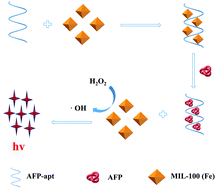A simple chemiluminescent aptasensor for the detection of α-fetoprotein based on iron-based metal organic frameworks†
Abstract
In this work, a sensing platform based on the luminol–H2O2–metal organic framework (MOF) system was constructed. The relationship between the α-fetoprotein (AFP) concentration and the chemiluminescence signal was obtained using the aptamer as the target recognition element. Three iron-based metal organic frameworks (Fe-MOFs) were prepared and compared. All the three Fe-MOFs with their active sites showed high catalytic performances. Among Fe-MOFs, MIL-100 (Fe) showed the highest catalytic activity. Thus, MIL-100 (Fe) was chosen as a peroxidase-like material and was used to construct a simple chemiluminescent (CL) aptasensing platform based on the electrostatic adsorption of the positive charge of MIL-100 (Fe) and the negative charge of the aptamer. In the presence of H2O2 and luminol, α-fetoprotein (AFP) induces aptamer conformational changes to stimulate the generation of CL. Under optimal conditions, the CL signal was linearly proportional to the AFP concentrations in the range from 1.0 × 10−10 g L−1 to 3.0 × 10−5 g L−1. The detection limit was 7.7 × 10−11 g L−1 (3δ), indicating high sensitivity of this method. Undoubtedly, the reliability and easy operation of this analysis platform is a promising criterion for AFP detection in remote areas.



 Please wait while we load your content...
Please wait while we load your content...